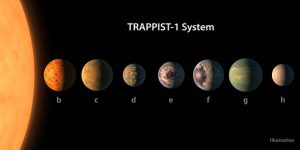
Pe 22 Februarie 2017, printr-un comunicat de presă, NASA face un anunț istoric în ceea ce privește descoperirea unui sistem exoplanetar, denumit TRAPPIST-1, care găzduiește șapte planete comparabile (ca mărime și compoziție) Pământului; trei dintre ele se află în zona locuibilă cu potențial de a avea apă. Steaua, o pitică rece, aflată la aproximativ 40 de ani lumină față de Pământ, poartă denumirea misiunii TRAPPIST – Transiting Planets and Planetesimals Small Telescopes.
”Un an lumină înseamnă cam nouă trilioane de kilometri. Adică la un miliard mai adaugați încă trei zerouri. În acest moment, noi înca nu putem să percem să parcurgem o astfel de distanță cu capabilitățile noastre umane. Probabil, este necesară o schimbare de paradigmă, o schimbare de percepție, care ne va putea permite, sper într-un viitor foarte apropiat, să vedem cum putem accesa aceste stele”, explică Președintele Agenției Spațiale Române (ROSA), Dr. Marius-Ioan Piso, într-un interviu acordat la Radio France International (RFI).
Observațiile sistemului exoplanetar TRAPPIST-1 datează din 2015, când o echipă de astronomi de la Universitatea Liege, din Belgia, au decodificat primele date obținute cu telescopul Liege TRAPPIST-Sud din Chile. Observațiile au continuat prin implicarea mai multor telescoape la sol (TRAPPIST-Nord în Morocco, UK Infrared Telescope – UKIRT în Hawaii, telescoapele William Herschel și Liverpool în La Palma și telescopul Observatorului Astronomic Sud African) și în spațiu (telescopul spațial Spitzer al NASA).
“Pentru a intra în detaliu asupra compoziției atmosferei, sau a structurii rocii acelor planete, mai avem înca de acordat probabil zeci de ani de acum incolo”, explică cercetătorul științific, Dr. Gina Isar, într-un interviu acordat la Antena 1 Observator TV.
Confirmarea existenței sistemului exoplanetar TRAPPIST-1 a fost facută de către NASA (National Aeronautics and Space Administration), prin efectuarea unor observații spațiale îndelungate și mai precise cu telescopul spațial Spitzer. Rezultatele remarcabile obținute au fost publicate recent în revista științifică Nature, care conclud că: “Sistemul TRAPPIST-1 reprezintă o oportunitate unică pentru a caracteriza planete asemănătoare Pământului care orbitează o stea mult mai mică si mai rece decât Soarele” [Gillon, M. et al. Nature, 2017].
Telescoapele TRAPPIST fac parte dintr-un proiect mai larg, denumit SPECULOOS – Search for habitable Planets EClipsing Ultra-cOOl Stars, al cărui obiectiv este să observe mai multe sisteme de acest tip, cu patru telescoape noi în Chile.
Observațiile vor continua, atât la sol cât și în spațiu, cu viitoare telescoape performante.
Mai multe informații despre telescoapele TRAPPIST pot fi găsite aici.
Mai multe informații despre proiectul SPECULOOS pot fi găsite aici.
